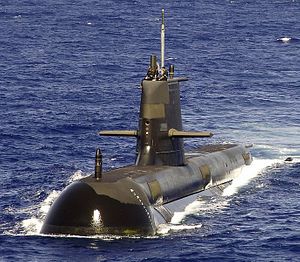My that was exhausting, but it’s finally over now. Australia has chosen France’s DCNS to build its new fleet of a dozen submarines to replace the six Collins-class diesel-powered boats currently in service.
The fifteen-month Competitive Evaluation Process (CEP) trundled along with decisions being made behind closed doors. Neither the arrival of Malcolm Turnbull to replace a pro-Japanese Soryu Tony Abbott, the appointing of Australia’s first female defense minister in Marise Payne, nor even a much-awaited and very delayed defense white paper gave a clue as to whether Germany, France or Japan would land the contract. Nor was it made clear where the submarines would be built. A local build had a very strong domestic politics component and South Australian votes and political support from independents like Senator Nick Xenophon is crucial. Newspapers and policy tanks, the Australian Strategic Policy Institute (ASPI) especially, devoted much time to theorizing who would build what where, and why. Cases were made for all three. If this stuff interests you there is a good back catalogue of interesting information to be had.
The Diplomat has been covering the submarine saga for some time, noting the enthusiasm Tony Abbott had for both Japan’s Soryu and a closer relationship with Tokyo. Could a Japanese-build and technology sharing with the U.S. have led to a kind of trilateral alliance? In which case what does China think? Sam Roggeveen at Lowy’s Interpreter blog pointed out that Beijing may have less cause for alarm, but that Australia is doubling its submarine fleet sends a strong message in any case. Another message, one that Beijing kept reasonably quiet on, was the tenor of the white paper: very much about sticking to the “rules-based order.” In other words, Beijing should stop being “counterproductive” (Malcolm Turnbull) in its island-building.
The CEP allowed three pre-selected nations to compete, rather than an open tender which Tony Abbott suggested would lead to the possibility of “Vladimir Putin submarines.” That Sweden’s Kockums was not allowed a shot seemed perplexing given they built the Collins-class, maligned though the “dud subs” have been at times. Abbott apparently also allowed Japanese Prime Minister Shinzo Abe to believe that Australia would be interested in a single supplier, no hoop-jumping one-in-three contender, which is embarrassing for both nations at a time when closer relations are valued.
As ASPI’s Andrew Davies has pointed out, “But DCNS in 2016 has some advantages compared to Kockums, the Swedish designer of the Collins class submarines, when the winner of the Collins tender was announced back in 1987. The new project is starting with a higher baseline of domestic industrial capability and a more sophisticated national understanding of what it takes to build and support a fleet of submarines… But we’re also aiming to produce a larger and more sophisticated submarine than the Collins, which pretty much guarantees unexpected technical problems.” In other words there’s good and bad, which can be said of any project as complex as collaboration on 12 large submarines, one of the most complicated pieces of equipment in the world. The problems this new build has will be unique to itself, not repeated mistakes of the past.
Or as Marise Payne has put it, in a joint press release, and paraphrasing previous government papers, “The Future Submarine project is the largest and most complex defence acquisition Australia has ever undertaken. It will be a vital part of our Defence capability well into the middle of this century.”
She notes the obvious benefits to Australia (and 1,100 jobs is good political capital in this time of “transition in the economy post-mining boom). Why France though?
“This decision was driven by DCNS’s ability to best meet all of our unique capability requirements. These included superior sensor performance and stealth characteristics, as well as range and endurance similar to the Collins Class submarine. The Government’s considerations also included cost, schedule, program execution, through-life support and Australian industry involvement.” Though completely ignoring any strategic angle Payne has summed up good parts of the debate that’s gone on for a while: Australia needs rather unique machines with endurance given the vast waters that surround the island continent. However, improving capability in the local shipbuilding industry, not outsourcing, remains important. Domestic politics will always hold sway, even in defense and strategy decisions.

































